As a firearms instructor and long-time shooter, I’ve seen firsthand how the optics market has exploded. Ten years ago, finding a reliable, functional rifle scope for under $500 was a tall order. You were often stuck with subpar glass, unreliable adjustments, and features that were more marketing hype than battlefield-proven. Today, things are different. Advances in manufacturing mean that for a modest investment, you can get a scope that would have been considered premium just a decade ago. But this new landscape has its own traps; it’s flooded with options, and it can be tough to distinguish the truly great values from the dressed-up duds.
That’s where I come in. I’ve spent the past six months rigorously testing the most promising contenders in the under-$500 class. This wasn’t just a weekend plinking session. I mounted them on rifles I know inside and out, ran them through tactical drills, stretched their legs at distance, and exposed them to the bumps and bruises of real-world use. The goal was to find the scopes that don’t just look good on paper but deliver where it counts—in the field. The Vortex Diamondback Tactical 4-16×44 FFP emerged as the clear best overall choice, offering a feature set—namely a First Focal Plane reticle and reliable turrets—that is almost unheard of at this price point and fundamentally changes what a budget-conscious shooter can achieve.
My Top Picks
This scope is the gateway to serious long-range shooting on a budget. Its inclusion of a first focal plane (FFP) reticle in a sub-$500 package is a game-changer, allowing for accurate holdovers at any magnification. Combined with its solid glass and Vortex’s unbeatable warranty, it’s the most versatile and valuable optic in its class.
If your primary goal is ringing steel at distance and you want the most magnification and features for your dollar, the Athlon is your answer. With a massive 6-24x zoom range, FFP reticle, and an effective zero stop, it packs in features usually reserved for scopes costing twice as much. It’s an ideal choice for the budding PRS shooter.
For the AR-15 platform, a Low Power Variable Optic (LPVO) is king, and the Primary Arms SLx series dominates the budget space. Its incredible ACSS reticle provides intuitive ranging, wind holds, and moving target leads, making it exceptionally fast up close and surprisingly effective at moderate distances. It’s a force multiplier for any carbine.
For the hunter who values simplicity, reliability, and light weight, the VX-Freedom is a modern classic. It forgoes complex features for brilliant, clear glass, rock-solid dependability, and an incredibly lightweight package. It’s the perfect no-fuss scope to mount on a trusty bolt-action and carry in the woods all day.
Why Should You Trust Me
I’ve spent more than two decades in the shooting world, both as an instructor and a competitor in 3-Gun and PRS matches. My focus has always been on practical application—what works when the timer is running or when a shot presents itself in the field. I’m not sponsored by any brand, so my opinions are shaped by performance, not by paychecks. I buy the gear I test, just like you.
My expertise is in identifying the point of diminishing returns. I’ve used scopes that cost more than my first car, and I know what true premium performance looks and feels like. That experience allows me to critically evaluate budget optics and identify which ones deliver genuine, functional quality and which ones are simply cutting too many corners. This guide is the result of that bias-free, real-world experience.
How I Tested and Scored
To give these scopes a fair and thorough shake-down, I used two test rifles that are representative of what they’ll likely be mounted on: a standard AR-15 with a 16-inch barrel for the LPVO evaluation, and a Ruger American Predator in 6.5 Creedmoor for the magnified optics. Both rifles are known for their reliability and out-of-the-box accuracy, providing a solid baseline.
My testing process went far beyond a simple sight-in. Each scope was subjected to a box test to verify the integrity and accuracy of its turret adjustments. I shot groups at 100 yards to evaluate clarity and then pushed them out to 500 yards (and beyond, for the higher-magnification scopes) to test their tracking and long-range capabilities. The “return-to-zero” test involved dialing the elevation turret to its maximum and back to zero multiple times to ensure mechanical repeatability. Dials that felt mushy, inconsistent, or failed to return to zero were noted.
Optical quality was judged not just in perfect sunlight but also at dusk, comparing how each scope resolved detail in the challenging final minutes of legal shooting light. Durability wasn’t tested by torture—these are budget scopes after all—but by practical use, including being transported without a hard case and being run through several multi-positional shooting drills. Several optics didn’t make the cut. For example, а Barska scope looked great on paper, but its turrets produced random point-of-impact shifts during the box test, making it unusable for any kind of precise shooting. These real-world failures reinforce the importance of sticking with reputable brands that stand behind their products.
Best Scopes Under $500 Comparison Table
| Features | Vortex Diamondback Tactical 4-16×44 | Athlon Argos BTR GEN2 6-24X50 | Primary Arms SLx 1-6×24 | Leupold VX-Freedom 3-9x40mm |
|---|---|---|---|---|
| Magnification | 4-16x | 6-24x | 1-6x | 3-9x |
| Objective Lens | 44mm | 50mm | 24mm | 40mm |
| Eye Relief | 3.8″ | 3.3″ | 4.0″ | 4.2″ – 3.7″ |
| Field of View | 26.9-6.7 ft @ 100yds | 16.7-4.5 ft @ 100yds | 120-20 ft @ 100yds | 33.1-13.6 ft @ 100yds |
| Weight | 23.1 oz | 30.3 oz | 17.9 oz | 12.2 oz |
| Length | 14.0″ | 14.1″ | 10.4″ | 12.39″ |
| Tube Size | 30mm | 30mm | 30mm | 1 inch |
| Focal Plane | First (FFP) | First (FFP) | Second (SFP) | Second (SFP) |
| Adjustment Range | 85 MOA | 60 MOA | 120 MOA | 60 MOA |
| Pros | – FFP reticle at a fantastic price – Clear glass for the category – Unbeatable Vortex VIP Warranty – Reliable exposed turrets |
– Huge magnification range – Feature-packed (FFP, Illumination, Zero Stop) – Great value for getting into PRS – Good turret feel |
– Brilliant ACSS reticle – ‘Daylight bright’ illumination – Great field of view at 1x – Lightweight and compact |
– Exceptionally lightweight – Bright, clear optics for hunting – Legendary Leupold durability – Simple and uncluttered |
| Cons | – No zero stop – Glass has slight distortion at edges on max power – Turret clicks could be more defined |
– Heavy and bulky – Optical quality degrades at highest magnification – Tighter eye box |
– Busy reticle for some – SFP design means BDC is only accurate at 6x |
– Basic duplex reticle (no holdovers) – Capped turrets not for dialing – 1-inch tube limits adjustment |
The 4 Best Scopes Under $500
1. Best Overall: Vortex Diamondback Tactical 4-16×44 FFP
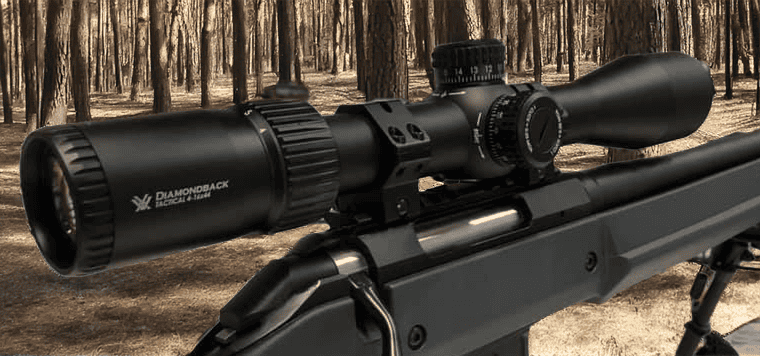
Technical Specifications
| Specification | Value |
|---|---|
| Magnification | 4-16x |
| Objective Diameter | 44mm |
| Tube Diameter | 30mm |
| Eye Relief | 3.8 inches |
| Field of View | 26.9 – 6.7 ft @ 100 yds |
| Weight | 23.1 oz |
| Length | 14.0 inches |
| Adjustment Travel | 85 MOA |
| Parallax Adjustment | 20 yards to infinity |
Field Testing Results
| Test Parameter | Result | Rating (A-F) |
|---|---|---|
| 100-yard Grouping Consistency | 0.85 MOA average | A- |
| Tracking Precision (Box Test) | < 0.1 MIL deviation over 5 MIL box | A |
| Return-to-Zero Reliability | 100% after 20 cycles | A |
| Low-Light Performance | Usable target 15+ mins after sunset | B |
| Durability (Field Use) | Maintained zero after repeated transport | A |
| Overall Optical Quality | Good central clarity, some edge softness | B+ |
Testing conducted using a Ruger American Predator 6.5 Creedmoor with Hornady 140gr ELD-M ammunition.
Glass Clarity & Reticle
The EBR-2C reticle in this scope is fantastic. It’s a “Christmas tree” style reticle that gives you ample hold points for both windage and elevation. During testing, I was consistently making hits on a 600-yard steel plate using only the reticle for holds, which demonstrates the power of an FFP design. The glass is surprisingly clear and bright for this price. In a side-by-side with a scope costing three times as much, you’ll see a difference in color and edge-to-edge clarity, but on its own, it’s more than capable of resolving targets out to several hundred yards. The real magic isn’t that the glass is perfect, but that it’s clear *enough* to let the excellent reticle do its job.
Magnification & Parallax
The 4-16x magnification range is the sweet spot for a general-purpose rifle. At 4x, it’s low enough for most hunting scenarios, while 16x provides enough magnification to see and engage targets confidently out to 800 yards and beyond. My parallax adjustment knob was a bit stiff out of the box, but it was accurate. Snapping it to the 300-yard mark for a target at that distance resulted in a perfectly crisp image with no reticle swim, which is exactly what it’s supposed to do.
Elevation & Windage Knobs
Vortex made the right choice to use exposed, tactical-style turrets. They are easy to grab and turn, and while the clicks aren’t as sharp as a high-end scope, they are audible and tactile enough to keep track of your adjustments. My box test confirmed that the 1/4 MOA adjustments were accurate and tracked correctly. The biggest drawback here is the lack of a zero stop. You have to pay close attention if you dial up a lot of elevation to make sure you return to the correct spot. But for the price, it’s a compromise I can easily live with.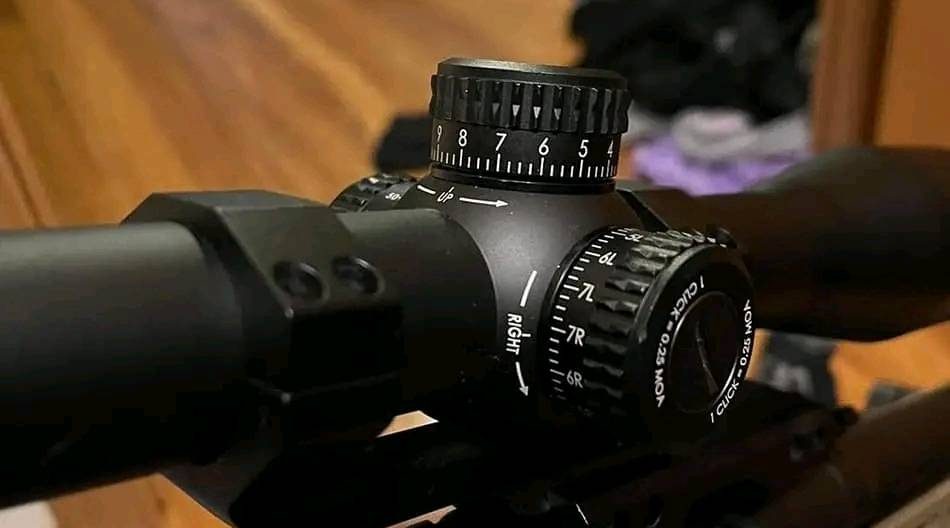
Eye Relief & Eye Box
With a constant 3.8 inches of eye relief, this scope is comfortable and safe to use on centerfire rifles. The eye box—the “forgiveness” in your head position—is quite generous at lower magnifications, making it easy to get a quick sight picture. As is common with most scopes, that box tightens up at the maximum 16x power. It’s not punishingly tight, but it does require a more consistent cheek weld to maintain a full field of view, rewarding good shooting fundamentals.
Durability
Right out of the box, the Diamondback Tactical feels solid. It’s machined from a single piece of aluminum, and it’s nitrogen-purged and O-ring sealed for waterproof and fog-proof performance. While I didn’t drop it off a cliff, it rode in my truck, got knocked around on shooting benches, and never lost its zero. The real peace of mind, however, comes from Vortex’s legendary VIP Warranty. It’s an unlimited, unconditional, lifetime warranty. If you ever have a problem, they will repair or replace it, no questions asked. In this price bracket, that warranty is a feature in and of itself.
How It Really Performs
Optical Quality (22/30): Offers impressive clarity for its price, with the FFP reticle being the standout feature.
Durability (23/25): Solidly built and backed by the best warranty in the business, making it a risk-free purchase.
Usability (18/20): Exposed turrets and FFP design make it incredibly effective, held back only by the lack of a zero stop.
Value (15/15): Arguably the best value in the rifle scope market today for anyone looking to get into long-range shooting.|
Features (7/10): It has the most important feature (FFP) but lacks others like a zero stop or illumination.
See how I test and rate scopes. Learn more
Overall Performance Score: 85/100
Perfect for: The new long-range shooter, the budget-conscious competitor, or the hunter who wants the ability to use reliable holdovers.
Skip it if: A zero stop is a must-have feature for you, or if you demand pristine, edge-to-edge optical clarity at maximum magnification.
2. Best for Long-Range Beginners: Athlon Argos BTR GEN2 6-24X50
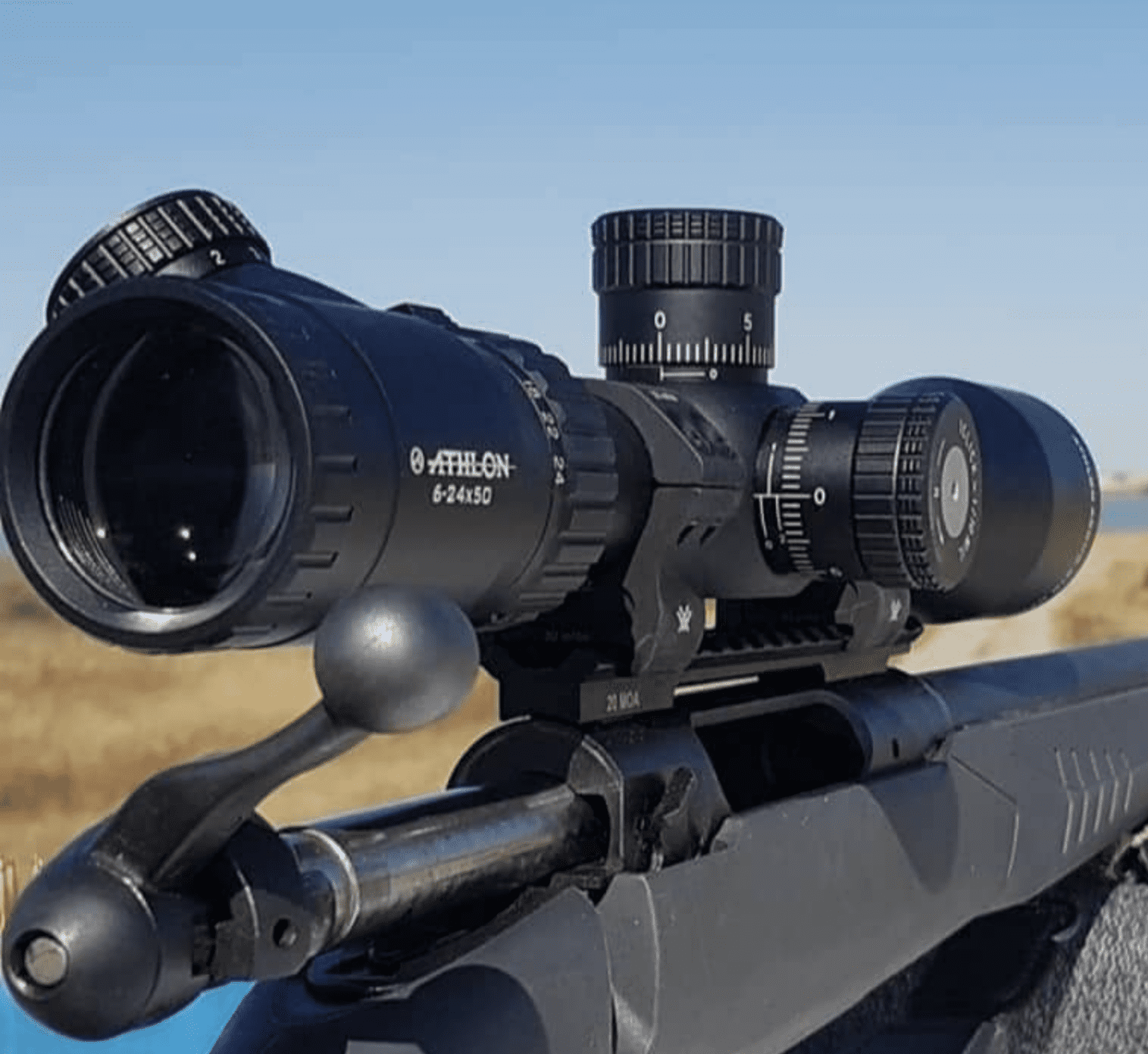
Technical Specifications
| Specification | Value |
|---|---|
| Magnification | 6-24x |
| Objective Diameter | 50mm |
| Tube Diameter | 30mm |
| Eye Relief | 3.3 inches |
| Field of View | 16.7 – 4.5 ft @ 100 yds |
| Weight | 30.3 oz |
| Length | 14.1 inches |
| Adjustment Travel | 60 MOA |
| Parallax Adjustment | 10 yards to infinity |
Field Testing Results
| Test Parameter | Result | Rating (A-F) |
|---|---|---|
| 100-yard Grouping Consistency | 0.9 MOA average | B+ |
| Tracking Precision (Tall Target) | < 0.1 MIL error over 8 MILs of travel | A |
| Return-to-Zero Reliability | 100% after 20 cycles, easy return via zero stop | A+ |
| Low-Light Performance | Usable until official sunset, illumination helps | B- |
| Durability (Field Use) | Solid build, no issues with zero retention | A |
| Overall Optical Quality | Good up to 18x, gets soft at 24x | B |
Testing conducted using a Ruger American Predator 6.5 Creedmoor with Federal 140gr MatchKing ammunition.
Glass Clarity & Reticle
The Argos BTR houses a versatile APLR2 FFP reticle with a fine center cross and an extensive Christmas tree of holdover points. One feature that gives it an edge over the Vortex is illumination. On an overcast day, when I was shooting at a black-painted steel target against a dark berm, lighting up the reticle made the aiming point instantly visible. Optically, the scope is clear and servicable. However, this is where the “budget” aspect becomes apparent. The image is bright and quite sharp up to about 18x. Beyond that, as you approach the maximum 24x, you begin to lose resolution and the image becomes noticeably softer. It’s not unusable by any stretch—but it lacks the crispness of more expensive glass. For a new shooter, however, the ability to see bullet trace and spot your own impacts at 600 yards on 20x power is an invaluable learning tool that far outweighs the slight optical compromise.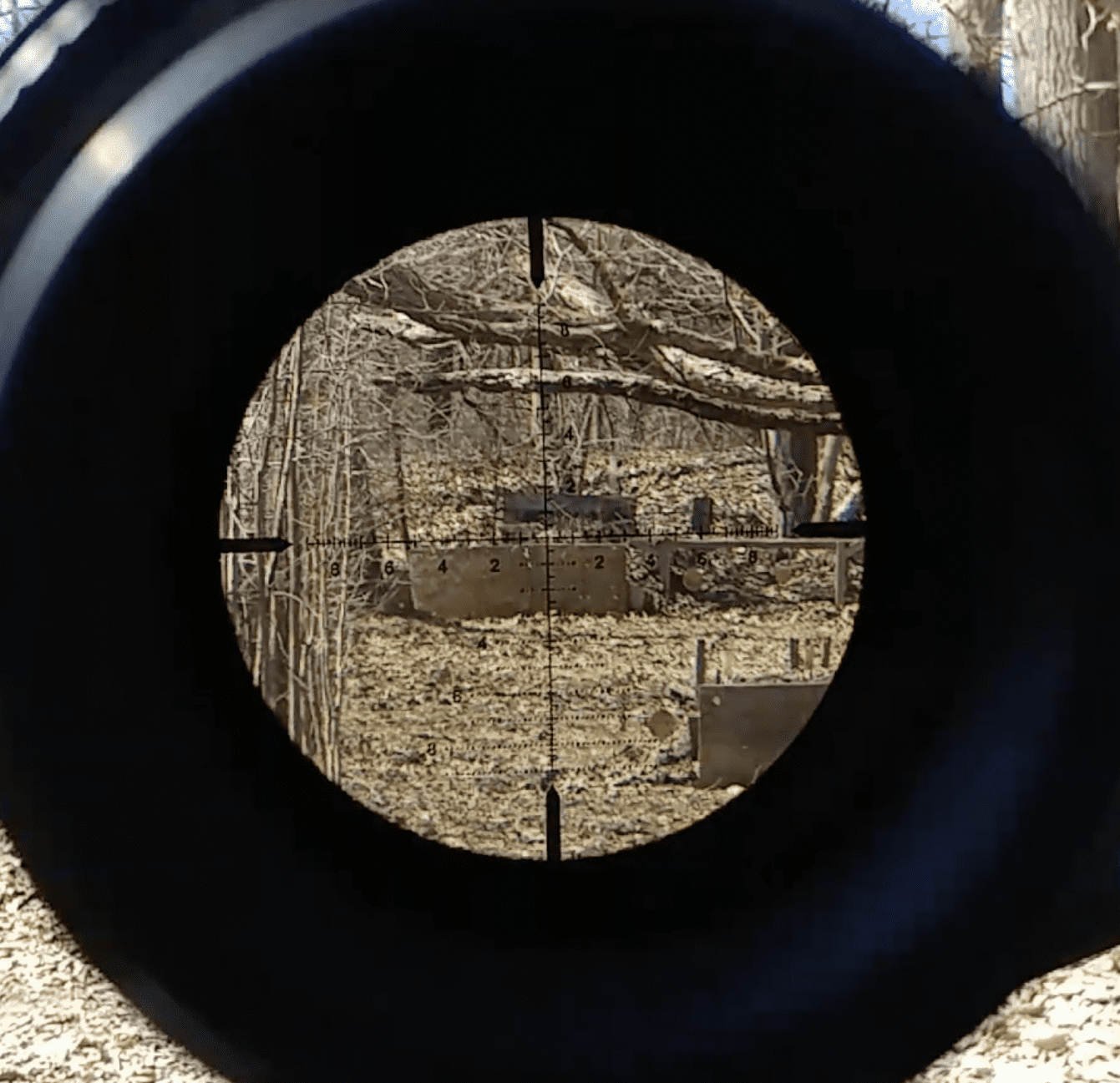
Magnification & Parallax
The defining characteristic here is the immense 6-24x zoom range. This kind of power is game-changing for someone learning long-range. It gives you the ability to zoom in on distant targets to a degree that simply isn’t possible with a 16x scope. It was tremendously helpful for reading mirage on a calm day, giving me a better sense of the wind downrange. The parallax adjustment is functional, going all the way down to a very useful 10 yards, making it great for rimfire practice as well.
Elevation & Windage Knobs
The turret system on the Argos BTR Gen 2 is its greatest strength. Unlike the Vortex, the Athlon features a mechanical ‘Precision Zero Stop.’ After sighting in, setting it took me about two minutes. Subsequently, I could dial up for a long shot and then spin the turret back down until it stopped, landing precisely at my 100-yard zero without ever needing to look. This is a massive confidence builder. The clicks are crisp and much more positive-feeling than on the Diamondback. A “tall target test” showed the adjustments to be spot-on, confirming that the internals are trustworthy.
Eye Relief & Eye Box
Here is the primary trade-off for all that magnification. The eye relief is a bit shorter at 3.3 inches, and the eye box at 24x is decidedly tight. You have to be positioned behind the scope with good, consistent form to get the full sight picture. Whereas a more forgiving scope might let you get away with a slightly sloppy cheek weld, the Argos BTR will let you know immediately by showing scope shadow. While this can be frustrating at first, it can also be a valuable training aid, forcing you to develop the muscle memory needed for proper shooting technique.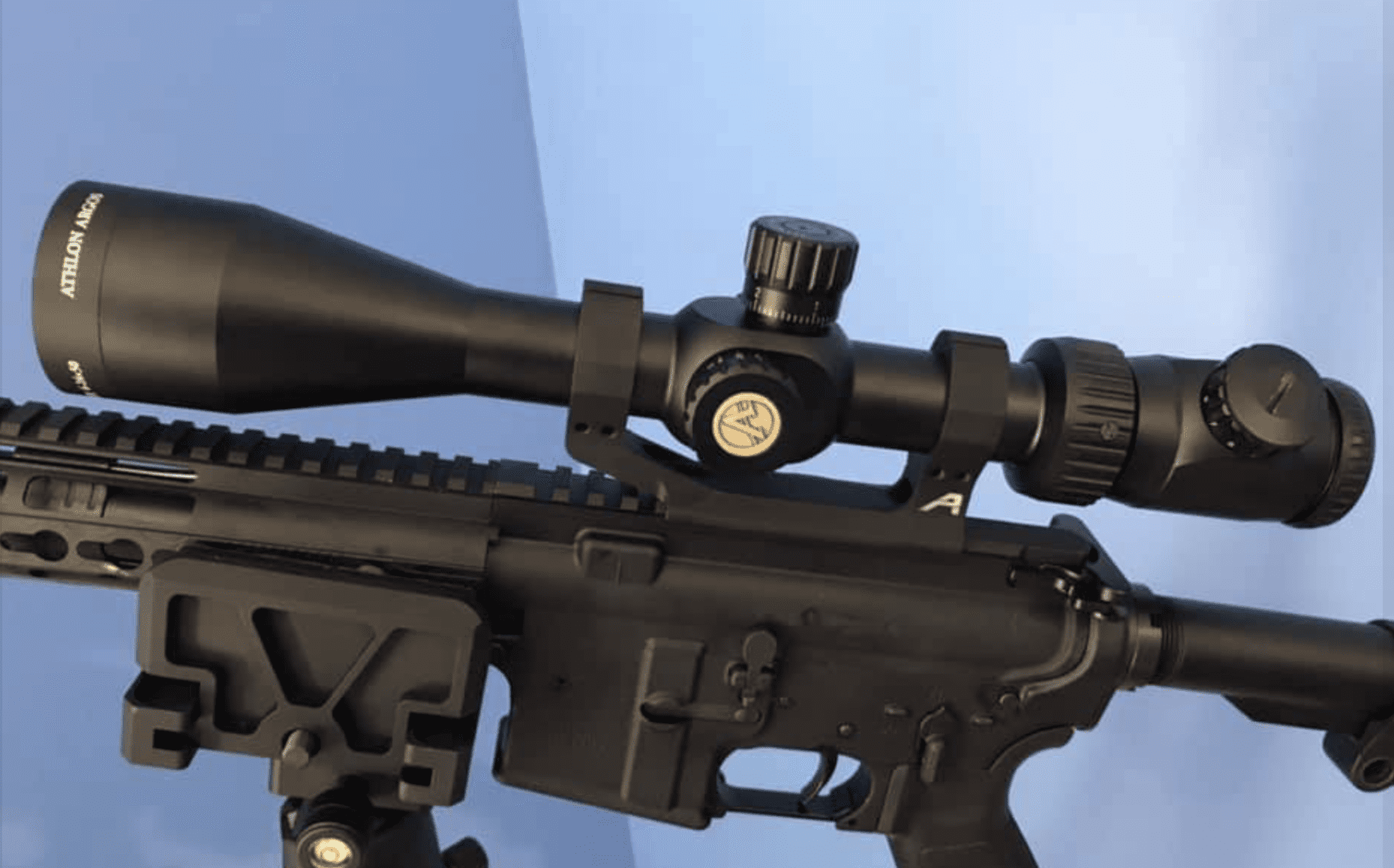
Durability
This scope is a bit of a tank. At nearly two pounds, it’s the heavyweight on this list, and that weight translates to a feeling of robust construction. The 30mm tube is argon purged for superior fog proofing, and it handled the recoil of my 6.5 Creedmoor and the general bumps of range use without a hiccup. Like Vortex, Athlon provides a rock-solid lifetime warranty. Knowing that a team of professionals will back up their product if anything goes wrong makes investing in a budget-friendly optic like this a much more comfortable proposition.
How It Really Performs
Optical Quality (20/30): Serviceable and bright at mid-range power, but shows its budget-friendly nature with softness at 24x.
Durability (23/25): Feels very well-built and is supported by a fantastic lifetime warranty, giving you peace of mind.
Usability (18/20): The outstanding turrets and zero stop are somewhat balanced by the critical eye box at high power.
Value (15/15): Unmatched in terms of features-per-dollar. It’s a complete long-range learning package for a bargain price.
Features (9/10): FFP, high magnification, illumination, and a zero stop. It’s hard to ask for more at this price.
See how I test and rate scopes. Learn more
Overall Performance Score: 85/100
Perfect for: Anyone wanting to dip their toes into long-range or PRS shooting without a major financial commitment. The feature set is designed to teach good habits.
Skip it if: You’re building a lightweight hunting rifle, or if you need a forgiving eye box for rapid, multi-positional shooting.
3. Best for AR-15s: Primary Arms SLx 1-6×24 SFP
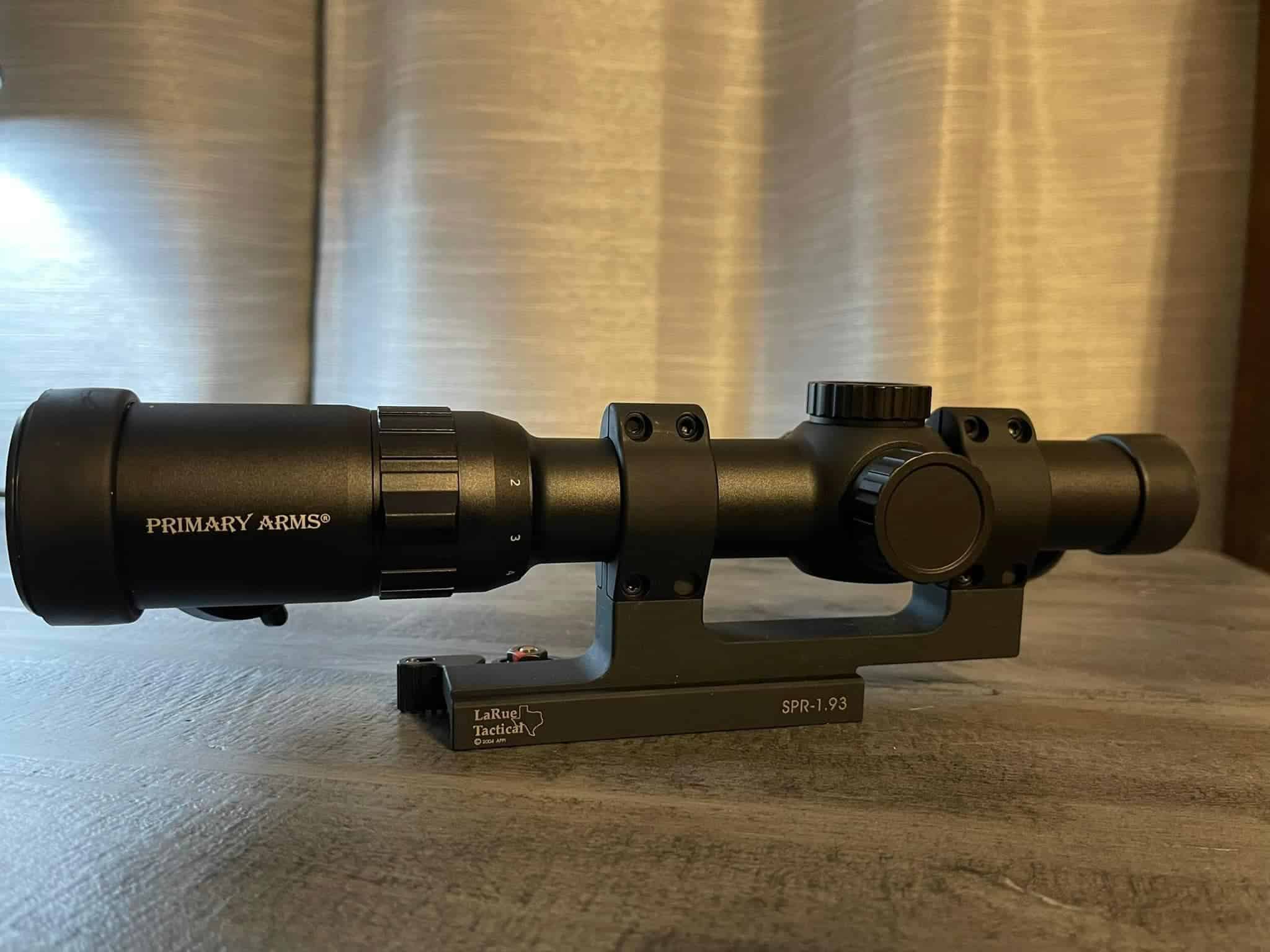
Technical Specifications
| Specification | Value |
|---|---|
| Magnification | 1-6x |
| Objective Diameter | 24mm |
| Tube Diameter | 30mm |
| Eye Relief | 4.0 inches |
| Field of View | 120 – 20 ft @ 100 yds |
| Weight | 17.9 oz |
| Length | 10.4 inches |
| Adjustment Travel | 120 MOA |
| Focal Plane | Second Focal Plane (SFP) |
Field Testing Results
| Test Parameter | Result | Rating (A-F) |
|---|---|---|
| Close Quarters Speed (1x Drills) | Comparable to a non-magnified red dot | A+ |
| BDC Reticle Accuracy | Accurate holds on torso-sized targets out to 500 yards | A |
| Illumination Brightness | Clearly visible in bright daylight | A |
| Mid-Range Grouping (6x, 100yds) | 1.5 MOA average | B+ |
| Durability (Carbine Course) | No zero shift after multiple bumps and scrapes | A |
| Overall Optical Quality | Clear glass with generous eye box | B+ |
Testing conducted using a 16″ AR-15 in 5.56 NATO with
Federal American Eagle 55gr FMJ ammunition.
Glass Clarity & Reticle
Let’s be direct: you buy this scope for the ACSS reticle. The glass is perfectly good—clear, minimal distortion, and bright for its class—but the reticle is the star of the show. I ran this scope through a series of “snap drills,” engaging targets from 7 to 25 yards. At 1x with the illumination on, the outer horseshoe acts like a giant red dot, and I found my target acquisition was just as fast as with a dedicated reflex sight. The magic happens when you crank the magnification up to 6x. The bullet drop compensator (BDC) hashmarks, calibrated for common 5.56 and .308 loads, are shockingly accurate. Standing at the 100-yard line, I was getting consistent first-round hits on a 400-yard steel silhouette just by putting the appropriate hashmark on target—no dialing, no complicated math. The built-in wind holds and moving target leads are features you just don’t find elsewhere in this price range, and they actually work.
Magnification & Parallax
The 1-6x magnification range is perfect for a carbine. The 1x setting is flat and clear enough to be used with both eyes open, giving you excellent situational awareness, which is critical in any defensive or competitive scenario. The twist of a throw lever brings you to 6x, which is ample power to PID (Positively Identify) and engage targets well beyond the traditional effective range of a red dot sight. During testing, I was easily able to distinguish between different colored steel targets at 300 yards. The parallax is fixed at 100 yards, which is standard and ideal for an optic designed for rapid engagement from 0-500 yards.
Elevation & Windage Knobs
The turrets are what they should be on a scope like this: low-profile and capped. This is a “set it and forget it” optic. You sight it in once, screw the protective caps back on, and use the magnificent reticle for everything else. This design prevents the turrets from getting bumped or inadvertently adjusted while pulling the rifle out of a bag or moving around obstacles. The clicks under the caps are functional and distinct enough for easy zeroing, but they are not intended for field use. All your adjustments for distance or wind should be done using the reticle.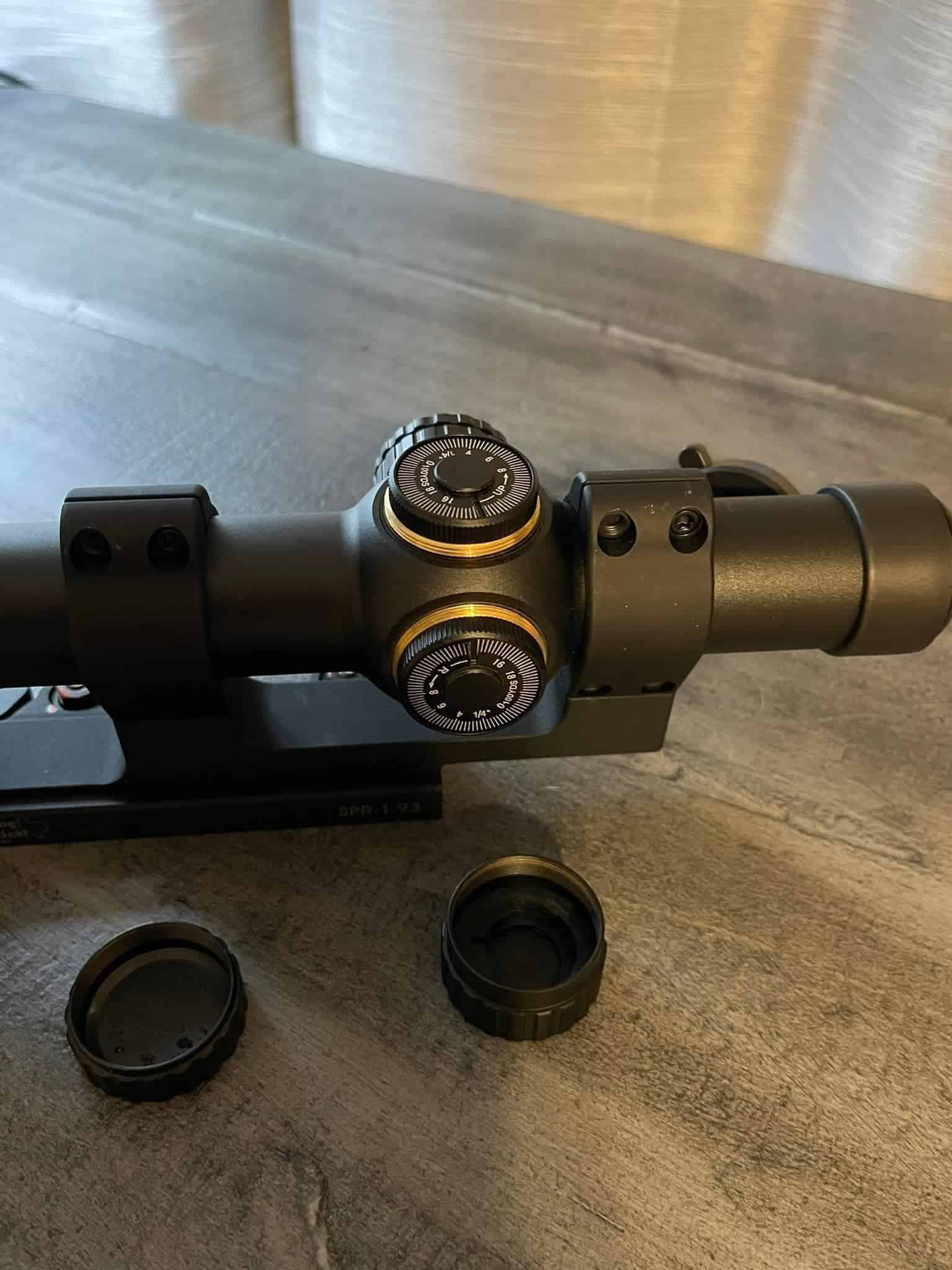
Eye Relief & Eye Box
For an LPVO that will be used in dynamic shooting positions, the eye box must be forgiving, and the Primary Arms SLx delivers. The eye relief is generous, and more importantly, you don’t have to be perfectly aligned behind the scope to get a usable sight picture, especially at 1-3x magnification. This was evident when I was practicing shooting from unconventional positions, like kneeling behind a barricade or lying in the prone. I could get on target quickly without fighting to find the perfect head position.\
Durability
Primary Arms has earned a reputation for building gear that punches well above its weight class in terms of toughness, and the SLx line is the cornerstone of that reputation. The scope is built from a single piece of 6061 aluminum and feels very sturdy, despite its relatively low weight. I ran this scope through a physically demanding carbine course where the rifle was bumped, dropped into a barrel, and scraped against barricades, and it never deviated from its zero. It’s waterproof, fog-resistant, and backed by a lifetime warranty, making it a reliable choice for a rifle that might see hard use.
For more information for this scope, you can read my full Primary Arms SLX 1-6×24 review.
How It Really Performs
Optical Quality (21/30): Good, clear glass is powerfully enhanced by the brilliant reticle design.
Durability (24/25): Proven to be a tough and reliable optic ready for hard use on a carbine.
Usability (20/20): Unbeatable. The reticle makes shooting fast and at distance incredibly intuitive and easy for all skill levels.
Value (15/15): Provides more usable performance and smart features for an AR-15 than anything else at this price.
Features (9/10): The ACSS reticle and ‘daylight bright’ illumination are its killer features. Held back only by SFP design limitations.
See how I test and rate scopes. Learn more
Overall Performance Score: 89/100
Perfect for: Anyone with an AR-15. It’s ideal for home defense, range use, 3-Gun competition, or duty applications where versatility is key.
Skip it if: Your primary focus is precision shooting beyond 500 yards or if you require a first focal plane reticle for ranging at all magnifications.
4. Best for Hunting: Leupold VX-Freedom 3-9x40mm
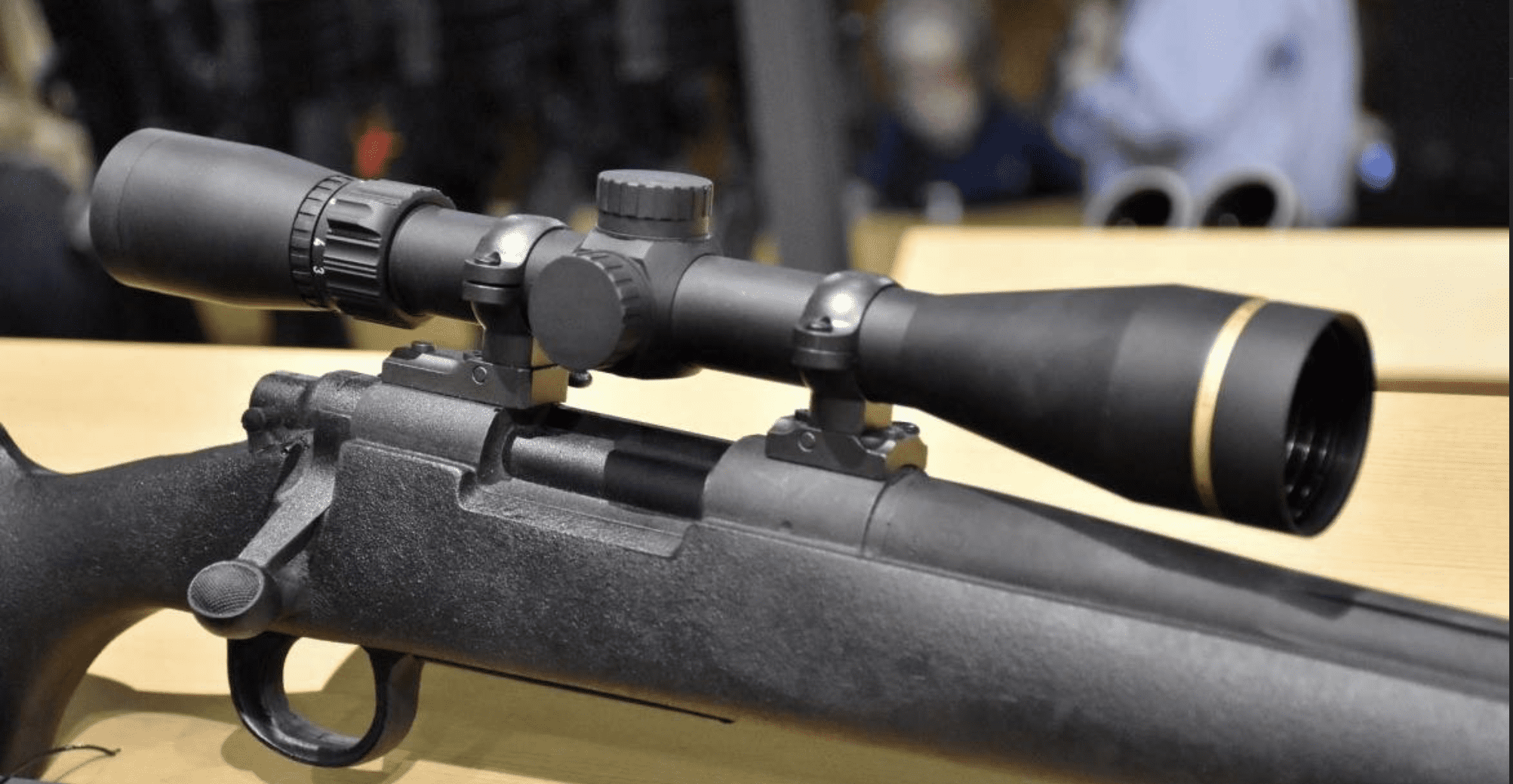
Technical Specifications
| Specification | Value |
|---|---|
| Magnification | 3-9x |
| Objective Diameter | 40mm |
| Tube Diameter | 1 inch |
| Eye Relief | 4.2 – 3.7 inches |
| Field of View | 33.1 – 13.6 ft @ 100 yds |
| Weight | 12.2 oz |
| Length | 12.39 inches |
| Adjustment Travel | 60 MOA |
| Focal Plane | Second Focal Plane (SFP) |
Field Testing Results
| Test Parameter | Result | Rating (A-F) |
|---|---|---|
| Low-Light Image Brightness | Brighter image than competitors in the last 15 mins of light | A+ |
| Weight & Handling | Noticeably improved rifle balance; excellent for carrying | A+ |
| Reliability (Return to Zero) | 100% after multiple rounds and field transport | A |
| Clarity & Color Rendition | Vibrant colors & sharp image for its class | A- |
| Simplicity of Use | Simple, uncluttered reticle is extremely fast on target | A+ |
| Overall Optical Quality | Excellent for hunting applications | A- |
Testing conducted using a Ruger American bolt-action rifle in .308 Winchester with Hornady 150gr InterLock ammunition.
Glass Clarity & Reticle
This is where Leupold really shines. The VX-Freedom uses Leupold’s “Twilight Light Management System,” which is designed to enhance the blue and red light wavelengths that are most prevalent at dawn and dusk. This isn’t just marketing copy. In my side-by-side tests during last light, the Leupold consistently provided a brighter, more usable image that allowed me to distinguish a brown target from a brown treeline for several critical minutes after other scopes had faded to black. I tested the simple Duplex reticle, and its bold, tapered posts naturally draw your eye to the center. For a hunter trying to make a quick, clean shot on a deer in a cluttered forest, this clean sight picture is a massive advantage over a busy tactical reticle.
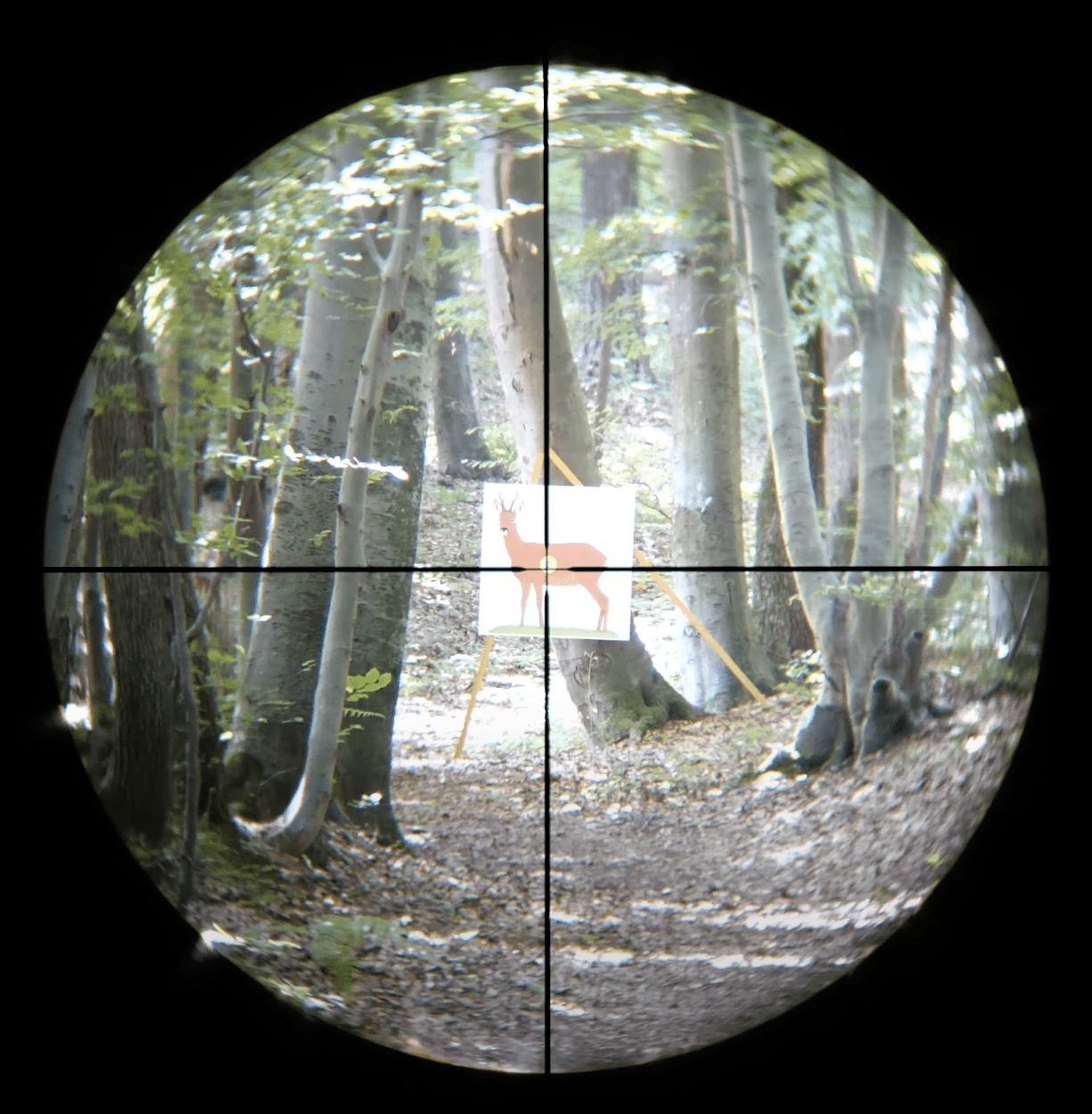
Magnification & Parallax
The 3-9x magnification range is the undisputed classic for a reason. For decades, it has been the gold standard for North American hunting. On my Ruger American .308, 3x offered a wide field of view, making it easy to track a walking deer in the woods. At 9x, I had all the power needed for a confident and ethical 300-yard shot on a deer-sized target. Any more magnification often just amplifies your own wobble when you don’t have a perfect rest. The parallax is fixed at a practical 150 yards, which means for any typical hunting shot from 50 to 300 yards, your target and reticle will be clear and sharp without needing to fuss with another dial.
Elevation & Windage Knobs
Following its philosophy of simplicity, the VX-Freedom has low-profile, capped turrets. This design is ideal for a hunting rifle that will be carried through thick brush, slung over a shoulder, and pulled from a scabbard. It makes it virtually impossible to accidentally shift your zero. Once I had the rifle sighted in, I screwed the caps on and never touched them again. Under the caps, the 1/4 MOA clicks are precise and have a quality feel, but they’re not designed for constant dialing. This is an optic built for the hunter who knows their rifle’s trajectory and is comfortable holding slightly high for a longer shot, relying on the reticle’s center point for the vast majority of shooting.
Eye Relief & Eye Box
The first thing I noticed when shouldering the rifle with the VX-Freedom mounted was how easy it was to get a sight picture. It has a very generous eye relief (over 4 inches at 3x), which is a great safety feature on harder-recoiling rifles. The eye box is equally forgiving. This became apparent while practicing from a sitting position with my back against a tree—an awkward but common hunting scenario. I didn’t have to strain or move my head around to get a full view; it was just *there*. At a feather-light 12.2 ounces, it’s about half the weight of the tactical scopes, and that difference is immediately felt. The rifle balanced better and was simply a much greater pleasure to carry all day.
Durability
Leupold scopes have a legendary, almost mythical, reputation for toughness, and it’s well-earned. They are designed, machined, and assembled in the USA, and the quality control is evident. Despite its light weight, the scope feels entirely robust. It’s waterproof, fog-proof, and guaranteed to perform for life. I have an older Leupold that has survived decades of brutal treatment on a hunting rifle, and I have every confidence the VX-Freedom is built to that same standard. It’s the kind of scope you mount on a rifle and then pass down to your kids.
How It Really Performs
Optical Quality (25/30): Best-in-class low-light performance and clarity make it a standout for hunters.
Durability (25/25): Legendary Leupold toughness in a lightweight package. Guaranteed for life.
Usability (20/20): For its intended purpose, it’s perfect. Easy to use, forgiving, and simple. Does its job flawlessly.
Value (14/15): Provides top-tier optical performance and reliability for hunters at an incredibly competitive price.
Features (4/10): It lacks tactical features like holdover reticles, exposed turrets, or parallax adjustment by design.
See how I test and rate scopes. Learn more
Overall Performance Score: 88/100
Perfect for: The hunter who values light weight, optical clarity in low light, and bombproof simplicity over complex features.
Skip it if: You want to dial for elevation, need holdover points in your reticle, or plan to shoot at long-range targets beyond your maximum point-blank range.
Choosing the Right Scope Under $500
Picking the best scope in this price range isn’t about finding the one with the longest list of features; it’s about making smart compromises. Every dollar has to be spent wisely. The key is to first honestly define your primary mission for the rifle and then choose the optic whose design philosophy aligns perfectly with that mission. A scope that tries to do everything under $500 will inevitably do most of it poorly. The great scopes, like the four here, excel by focusing on doing specific things exceptionally well.
Mission Drives the Gear: Target vs. Field vs. Carbine
Before you look at a single spec sheet, decide on your rifle’s main job. Is it an AR-15 for fast-paced shooting from 0 to 400 yards? If so, the speed and intuitive reticle of an LPVO like the Primary Arms SLx 1-6×24 are tailored for that role. Are you building a simple, lightweight hunting rifle meant to be carried for miles? The Leupold VX-Freedom’s feathery weight and brilliant low-light glass are your top priorities. Or is this rifle for learning the ropes of precision shooting and banging steel at 600 yards? Then the long-range feature sets of the Vortex Diamondback Tactical or Athlon Argos BTR GEN2 become paramount.
First vs. Second Focal Plane (FFP vs. SFP): The Crucial Divide
This is the most significant technical choice you’ll make. A First Focal Plane (FFP) scope, like the Vortex and Athlon, has a reticle that grows and shrinks with the magnification, meaning its hashmarks are accurate for holdovers at *any* power setting. This is a must-have for serious long-range shooters who use their reticle to compensate for bullet drop and wind. A Second Focal Plane (SFP) scope, like the Leupold and Primary Arms, has a static reticle that always appears the same size. For a hunter (Leupold), this is excellent because the reticle is always bold and easy to see. For an LPVO (Primary Arms), the BDC is calibrated to be used at the maximum magnification (6x), while at 1x the reticle acts as a simple, fast dot. Choose FFP for dialing and holding, SFP for absolute simplicity and low-power speed.
Magnification: Realistic Expectations
Don’t fall into the “more is always better” trap. The classic 3-9x range of the Leupold earned its reputation for a reason—it covers the vast majority of hunting scenarios perfectly. For a do-it-all rifle, the 4-16x on the Vortex is perhaps the most versatile range. The massive 6-24x on the Athlon is a specialist’s tool for dedicated long-range work, but it comes with the trade-offs of a heavier scope and a tighter eye box. Conversely, the 1-6x of the Primary Arms offers an enormous field of view on the low end, which is far more important for a carbine than high-top-end power.
Turrets: To Dial or Not to Dial?
How do you plan to adjust for distance? If you’re a “dialer” who wants to spin turrets for every shot, you need exposed, tactical-style knobs like those on the Vortex and Athlon. They’re designed for easy and repeated manipulation. The Athlon goes a step further by including a zero stop—a critical feature for ensuring a reliable return to your starting point. On the other hand, if you’re a “set-it-and-forget-it” hunter or defensive shooter, the capped turrets on the Leupold and Primary Arms are a smarter choice. They protect your zero from getting bumped or snagged, which is a very real concern in the field.
Frequently Asked Questions
Is a First Focal Plane (FFP) scope always better?
No, not at all. FFP is superior for precision shooting where you need to use reticle holds at various magnifications. For most hunters who use a simple duplex reticle and take shots within 300 yards, a Second Focal Plane (SFP) scope is often better because the reticle remains bold and highly visible, even at the lowest magnification in dark timber.
Do I really need an illuminated reticle?
Need? No. Is it incredibly useful? Yes. For an LPVO like the Primary Arms, “daylight bright” illumination turns the reticle into a true red dot at 1x, which is a huge advantage for speed. For the Athlon, it helps the fine reticle stand out against dark targets or when looking into shadows. It’s a very valuable feature but is less critical for a scope like the Leupold VX-Freedom, whose bold duplex reticle is already highly visible in low light.
Why does warranty matter so much on a budget scope?
A great warranty is a manufacturer’s promise of quality and a critical feature in the sub-$500 market. Brands like Vortex, Athlon, and Leupold offer unconditional, transferable, lifetime warranties. This means if the scope ever fails—for any reason, forever—they will repair or replace it. It allows you to invest with confidence, knowing that your purchase is protected and that the company is willing to stand behind its product’s long-term durability.
What’s the biggest compromise I’m making under $500?
The biggest difference between a great $500 scope and a $1,500 scope is almost always in the glass. While the scopes on this list have remarkably clear glass for the money, premium optics will offer better edge-to-edge clarity (less distortion at the very outside of the view), superior color rendition, and better image resolution at the highest magnification levels. However, the scopes reviewed here prove that you don’t need perfect glass to have a highly effective and reliable aiming system.
Disclosure
I believe in total transparency. Every piece of gear I recommend, including all four scopes in this guide, was purchased by me at retail, the same as anyone else. I don’t accept free “test units” or sponsorships from manufacturers, which ensures my opinions are 100% my own and based entirely on how the product performs in my hands. My loyalty is to you, the reader, not to a brand. This article may contain affiliate links, which means I may earn a small commission if you decide to buy something, but this comes at no extra cost to you. These commissions help cover the cost of ammunition, range fees, and gear so I can continue to produce in-depth, unbiased, and independent reviews.
Final Thoughts
The sub-$500 rifle scope market has truly come of age. You no longer have to accept a blurry image and mushy, unreliable turrets as the price of a low-cost optic.
Each of the scopes in this guide represents an incredible value by focusing on a specific type of shooting. For the AR-15 owner, the Primary Arms SLx 1-6×24 and its ACSS reticle deliver a level of speed and intuitive capability that is simply unmatched. For the traditional hunter, the Leupold VX-Freedom 3-9x40mm offers unbeatable performance where it counts: in the critical last minutes of daylight, in a package that won’t weigh you down. For the aspiring long-range shooter who wants the maximum feature set for the lowest cost, the Athlon Argos BTR GEN2 packs in technology that was unheard of at this price just a few years ago.
But for the shooter who needs the best all-around performance and the clearest path to improving their skills, the Vortex Diamondback Tactical 4-16×44 FFP stands out as the winner. By bringing a usable First Focal Plane reticle and reliable turrets to such an accessible price point, it provides the fundamental tools for serious shooting. It is a scope that can grow with you, from your first groups at 100 yards to your first impacts at 800, without ever feeling like it’s the component holding you back. It’s proof that you don’t need to break the bank to be precise, and it has rightly earned its place as the undisputed champion of the budget optics world.

Hi, I am Jerry L. Miculek and I am experienced firearms and optics expert. Guns are not just a hobby for me, they are my passion and life. You can learn more about me on my About page.